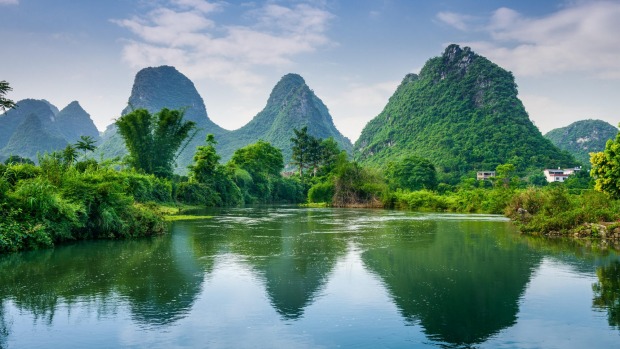
Around the Chinese city of Yangshuo, round-topped limestone mountains seem to bubble out of the earth. Winding between them, the Li River creates a scene so evocative it features on the Chinese 20-yuan banknote and was once listed by National Geographic as one of the 10 watery wonders of the world.
On a bicycle, it's a place that's not only gorgeous, it's also kind. There are rice-flooded valleys as flat as the hull of a barge, and roads run between the peaks rather than over them. Traffic is thinner than seems logically possible in a country of 1.3 billion people.
There are few more striking mountain landscapes in the world, and perhaps none so easily pedalled through. But first we have to get here. To reach these mountains, known throughout China as the "best under heaven", we must climb other mountains.
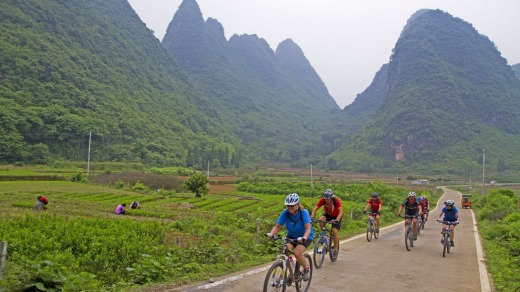
Our ride begins outside the city of Guiyang, the capital of the neighbouring province of Guizhou. A city of three million people, Guiyang is classic concrete China, with the city ringed by a sea of high-rise apartments and new super-highways that creep out through the countryside like cement fingers.
But as we leave the city, the only high-rises in the week ahead are natural. Little around Guiyang is flat, and over the next six days we'll make climbs totalling almost 5000 metres.
Some of the climbs grind on for 10 or 20 kilometres, though none of them are large. The highest we'll ride is around 1300 metres above sea level. Stitch a few climbs together, however, and it soon adds up. No more so than on our second day, when three lines of hills separate us from our day's destination of Yongle.
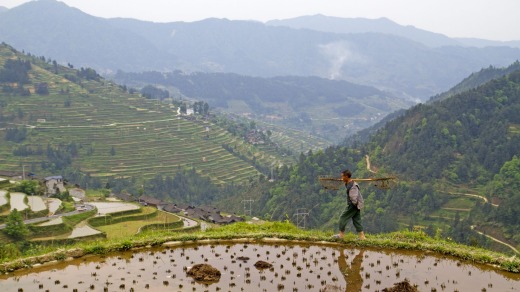
"We're staying in the best hotel in town," our guide Apple promises, by which she means we're staying in the only hotel in town. Briefly we're cycling off the tourist map.
Out of Leishan, where we lunch this day on rice noodles on the footpath in front of a store, we leave as a peloton, slowly spreading out as the climb takes grip. Beside the road, any flat bits of land have been converted into rice fields, with the stubble from the harvest resembling a buzz cut across the slopes.
Heads turn from cars as suddenly our bikes are the greatest show in Guizhou - for five days of riding, we don't see another Western tourist. There are smiles, stares, laughter and a baby's tears as we ride. Arms wave so frantically from school buses, it's almost as though the buses are trying to fly.
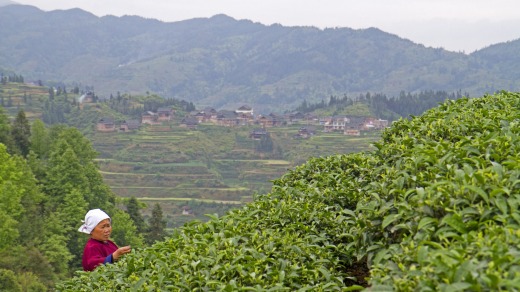
Finally, the road contours across to the 1300-metre-high pass, from where we stare down into the blue haze of the valleys we've just left. Mountains ripple away to the horizon.
The descent is over in minutes - too quickly, as they always are. Momentum hurtles us across a bridge, with the river beneath almost luminously green and the lush bush only shades behind. The next climb immediately begins...
The finest part of the day, the moment that makes every metre of climbing worthwhile, comes at its very end as we descend to Yongle. Every hillside around us is hooped with rice terraces, forming a stepladder of land down into the valley. The flooded terraces look like bits of the sky cut into the pieces of a jigsaw puzzle. Women stand up to their knees in water, planting rice and roaring with laughter as we pass. It's like every classic rice-field scene ever created, but with life stirred into it.
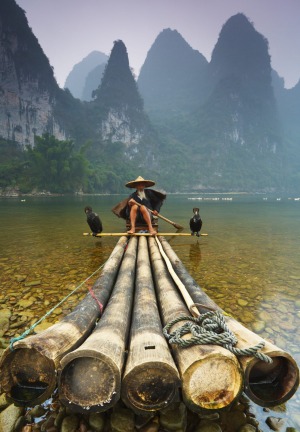
Two days later the hills change flavour. As we near the Guangxi border, the ranges are topped with tea plantations. Tea bushes cut perfect green stripes across the slopes, and pickers dot the fields. Far below, rice terraces fill the valleys. It's like riding through a Chinese lunch: tea and rice.
For all the shape in the land, the mountains in our mind are always those ahead around Yangshuo. After six days and 350 kilometres of cycling, we arrive in the riverside city that's framed around a multitude of karst peaks.
The extreme beauty of the setting has transformed Yangshuo into one of China's tourist giants. The shopping and eating district around West Street throbs with visitors, and yet there are secret passageways through the busy city.
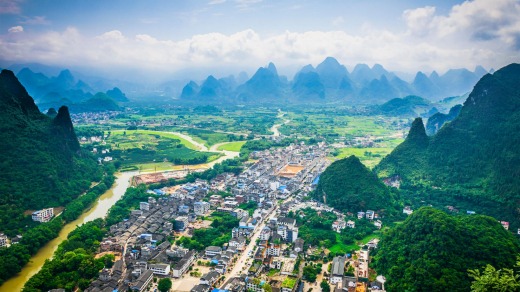
Pedalling out of Yangshuo the next morning, we leave along empty lanes too narrow for most vehicles. It feels like a European bike path winding out of a Chinese city.
For the next two days we'll pedal through this most mystical of landscapes, following the Li River upstream to Xingping before looping back to Yangshuo.
There are climbs here - rising up and between the karst peaks before rolling down into broad, flat-bottomed valleys - but you have to seek them out. And we do as we leave Yangshuo, rising slowly through orange groves and head to a lookout over the Li River. Peaks stand shoulder to shoulder along its banks, their shapes faintly etched into the haze. It could easily be Vietnam's Halong Bay drained of water.
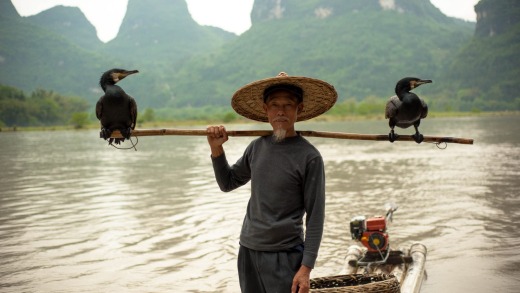
The lookout sits along perhaps the most scenic section of road we will cycle. Turn corners and suddenly there are blades of rock standing atop ridges and hills. Great tangles of green forest smother the peaks, white cliffs bursting out from their tops. It's China stripped back from concrete to limestone.
A few kilometres on, we plunge down a dirt track that threads between peaks to emerge at the riverbank. A cormorant fisherman, the human symbol of the Li River, glides past on a bamboo raft, his grey beard looking as ancient as his craft. We push the bikes onto a ferry and cross the river to Xingping, a town that's like Yangshuo in a more manageable bite, with its few souk-like lanes forming a scaled-down version of West Street. The finest things around the town, however, are natural.
At Xingping, the Li River takes the tightest of turns, banking around mountains and creating wraparound views for the town. Peaks angle out from the riverbank, resembling a dentist's dream of crooked fangs and molars.
The next morning - our final morning of cycling - we don't pedal out of Xingping; we float. At the town's edge, we load our bikes onto one of the Xingping's famed multitude of "bamboo rafts" (most are now made of PVC pipe) and motor off upstream to Yangdi.
For two hours the Li River will be our road, and one that's busier than any road we've cycled. Large river cruisers and hundreds of bamboo rafts jostle on the water. There are moments when it's like drifting through a Chinese silk painting, and other times when it's more like a racetrack.
At Yangdi we return to terra tarmac, cycling steeply out from the river before a glorious rolling ride all the way to Yangshuo, 55 kilometres away. It'll be a spectacular day in the saddle, our reward for days of effort, with the pedalling and the terrain now so easy after the week behind us.
In a region where the main roads roar with aggressive traffic, we see barely a vehicle as we turn down quiet concrete lanes into timeless scenes of rice fields pooled beneath shapely limestone domes and spires. Wispily bearded old men amble along the roads, leading water buffaloes. Together, we constitute almost the entire traffic flow.
At times we're not even on lanes as we switch to faint, muddy footpaths leading through the fields. A 600-year-old bridge sits forlorn and haunting beneath the mountains, vines hanging like dreadlocks from its parapets.
Momentarily we're forced onto a highway, and it's a reminder of how cosseted we've been from the storm of Asian traffic. Horns blare and cars overtake buses overtaking trucks. Then we're off again onto rural lanes, back among buffaloes, dogs and ducks. Instead of the chatter of horns, there's the chatter of birds and children.
Nearing Yangshuo we cross the Yulong River where, like us, a vast and ragged fleet of tourist bamboo rafts drifts towards the city. Mountains crowd the river, dominating the view but no longer our thoughts. These mountains are scenery, not obstacles.
MORE INFORMATION
cnto.org
GETTING THERE
China Southern Airlines flies daily from Sydney and Melbourne direct to Guangzhou, with connections to Guiyang and Guilin. See csair.com.
CYCLING THERE
SpiceRoads runs a 10-day Cycling Guilin's Karst Peaks trip that departs Guiyang and finishes in Guilin. It costs from US$2550, including all meals and accommodation. Bike hire is an additional US$120. Trips run from April to September. See www.spiceroads.com/tours/guilin
Alongside Guangxi's karst peaks, China has several other incredible natural features.
ZHANGJIAJIE NATIONAL PARK A veritable forest of rock in Hunan province, with quartz sandstone spires rising like quills from the forest. Parts of Avatar were filmed here.
ZHANGYE DANXIA LANDFORM GEOLOGICAL PARK With their bare slopes striped in vivid colours, it's not hard to see how these hills in Gansu province came to be known as the Rainbow Mountains.
TIGER LEAPING GORGE One of the world's deepest gorges, this Yunnan slot is 16 kilometres in length and almost four kilometres deep. A popular hiking trail runs through the gorge.
RED BEACH This marshland near Panjin is covered in a grass species that turns lipstick red around September and October, creating a vibrant red beach.
QIANTANG TIDAL BORE The mouth of the Qiantang River in Zhejiang province is home to the world's largest tidal bore, when water surges up the river, creating waves up to seven metres in height.